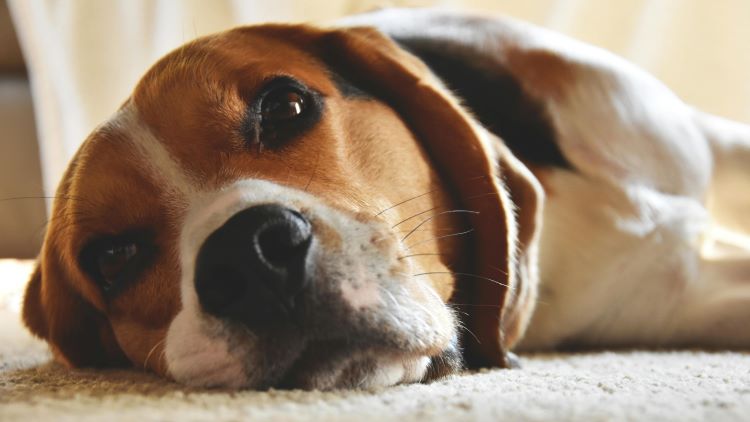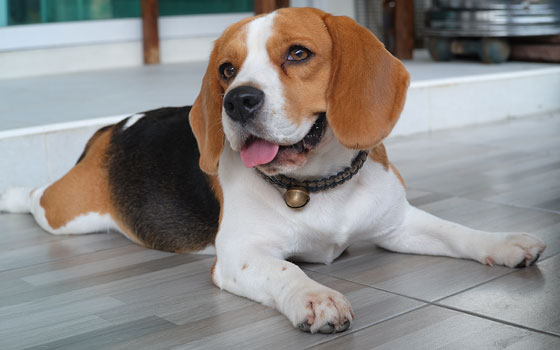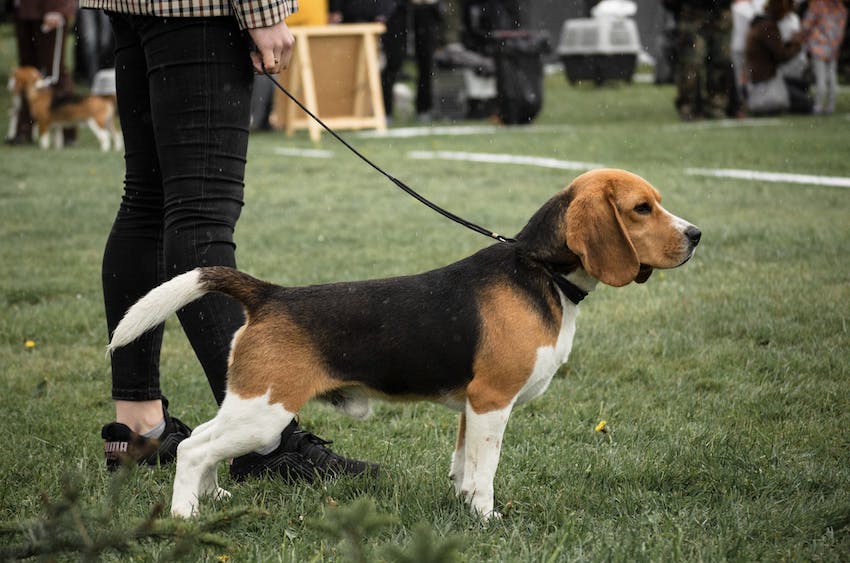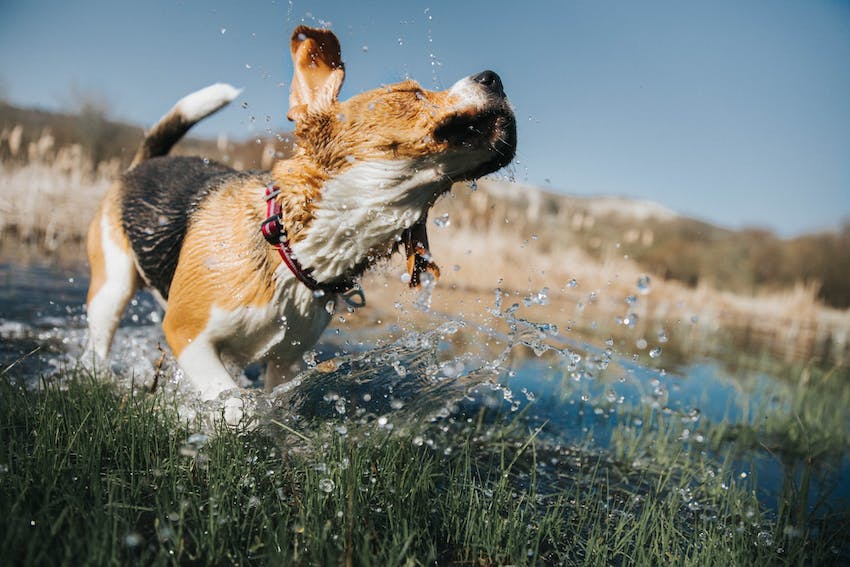Ready to help treat your pet to a healthy life?
Beagle Dog Breed Guide: History, Fun Facts & Care Tips
By : Trupanion Staff | Updated Sep 25, 2024

With their distinctive floppy ears, soulful eyes, and compact, sturdy build, Beagles are among the most beloved and popular dog breeds in modern history. Their energetic and social temperament makes them ideal companions for active families, while their intelligence and determination shine through in various roles, from hunting to scent detection. But is a Beagle the right pet for you? Whether you're considering one of these playful pets or are looking to learn more about the Beagle currently in your family, we've got you covered! In this detailed guide, we’ll explore everything you need to know about caring for and training a Beagle, as well as what makes these pups truly one of a kind.
8 fun facts about Beagles
- Beagles, like most hounds, are known for their baying. Baying is different than a regular bark — longer and more deep-throated. Most often, you’ll hear it when a Beagle catches a scent. A pack of Beagles all baying at once is quite an experience.
- The French word “be’geule” means “loudmouth,” for the sound hounds make while hunting, and might be where the Beagle got its name.
- Singer Barry Manilow is a Beagle fan — he owned a Beagle named Bagel in the 1970s, who appeared on several album covers.
- The United States Department of Agriculture's Animal and Plant Health Inspection Service (APHIS) has a "Beagle Brigade" at US airports, established in 1984. These talented canines sniff out contraband food, plants, and other restricted agricultural items. Their small size makes them less intimidating than larger detection dogs, and their friendly temperament puts people at ease.
- Before our modern-day Beagle, there were smaller versions of the hounds favored by royalty. Both Edward II and Henry VII kept packs of Glove Beagles, and Pocket Beagles were a favorite of Elizabeth I. They were miniature hounds, named for the things they were small enough to fit in: gloves or pockets. It’s said Elizabeth I allowed her Pocket Beagles to romp on top of tables when she entertained guests.
- Snoopy, from the comic strip Peanuts, is probably the most famous and well-known Beagle, although he doesn’t necessarily look quite like the real-life breed.
- While consistently popular in the United States, it wasn’t until 2008 that a Beagle named “Uno” won Best in Show at the Westminster Dog Show.
- Beagles typically live between 10 and 15 years. However, the longest-living Beagle is believed to be Butch, a Virginia pup who reached a whopping 27 years old!
Breed description
The Beagle is a type of small scent hound, with a wide nose and large ears that are perfect for tracking. They are similar in appearance to the larger Foxhound, though they tend to have less white and more reddish-brown in their coats. Pure-bred Beagles always have a white-tipped tail. That way they could be seen through the thick underbrush while on the hunt. While Beagles are usually tri-colored, they can rarely be found with all-white or white and very pale tan coats.
Beagles have a dense double coat, but since it’s short, it doesn’t require as much maintenance as other double-coated breeds. Tri-color Beagles are the most common (with coats of black, brown/tan, and white). Some Beagles are what’s called “particolored,” which is white and one other color — usually tan or brown for this breed. More rare Beagle colors include blue ticking, red ticking, and lemon.
Playful personality
In regards to temperament, the Beagle is a merry little hound who will always make their presence known by singing the song of their people. The world is all about one thing to a Beagle: following their nose... and their nose always finds its way to food. Beagles, like most hounds, have a one-track mind and are quite determined when they’re tracking a scent. Loving and playful, this breed is a hardy companion that is equally happy to run or nap.
Similar dog breeds
- Basset Hound
- Foxhound
- Harrier
- Dachshund

History of the Beagle
Scent hounds have long been a part of human history, helping to find and track game during hunts. In England, where the Beagle breed was developed, there are mentions of packs of smaller hounds being used in hunts since before the Romans invaded in the 1st century. The hounds of the United Kingdom have certainly been around since antiquity.
The Beagle can trace its history to the hounds used throughout medieval times, such as the Talbot Hound, which was brought to England by William I in 1066. Through time, smaller hounds were favored for hunting small game such as rabbits and hare. Miniature versions of the Beagle were popular with a few royals. Edward II and Henry VII had packs of Glove Beagles in the 14th and 15th centuries, and Queen Elizabeth I kept Pocket Beagles that were small enough to fit in saddlebags before being released to hunt. Her Pocket Beagles measured only 8 to 9 inches tall.
The term beagle was used as a catch-all for all the smaller sized hounds. No one knows for sure how the word became linked to the dogs. One theory is it’s derived from the Gaelic word “beag,” which means little. The most entertaining theory is that it came from the French word “be’geule,” roughly translated to loudmouth. That would certainly fit with the sounds these hounds let loose when they catch the scent during the hunt.
Changes over time
Different sizes and types of hounds were refined over the centuries in England. It wasn’t until the 1800s that the modern-day Beagle was truly refined. The Southern Hound and the North Country Beagle were used in the 1700s to hunt hare and rabbit but became rarer as fox hunting gained in popularity, which required larger hounds. Luckily, small hounds became the perfect hunting dog for those that could either no longer ride in fox hunts or simply couldn’t afford to keep horses for fox hunting. They could be used for foot hunting, easily followed on foot. The North Country Beagle and the Southern Hound merged into one Beagle breed by the 1840s, and these beagles were the foundation of the modern-day breed.
With the introduction of dog shows in England in the late 1800s, the Beagle became more standardized, but the breed became more popular in the United States. First imported after the Civil War, Beagles quickly found their place as perfect dogs for rabbit hunting. The first Beagle was registered with the American Kennel Club in 1885.
Beagles are one of the most food-motivated breeds, but their nose rules above all. If you want to share your life with a Beagle, understanding the one-track mind of a hound dog is essential. Start training when your Beagle is young to build strong foundation behaviors, and focus on training a solid come-when-called cue. A great way to build a relationship with your Beagle is to take advantage of their natural talents and sign up for nose work or tracking classes. They make excellent scent detection dogs, and this will give them an appropriate outlet for their desire to sniff.
Because a Beagle is determined to follow a scent once they’ve locked onto it, it’s important for their safety that they are kept on a leash or in a securely fenced area when off-leash. Otherwise, they will wander off on an adventure of their own making.

Behavior, exercise, and training
Beagles are generally very friendly dogs that love to be the center of attention. Proper proactive exposure to new sights, sounds, people, dogs, and other animals as a young puppy is essential for their socialization skills.
This breed can make an excellent family dog since it’s small but sturdy. Socialization as a puppy, proper introductions, and handling them with respect will go a long way in building good relationships with kids. Young children and dogs should always be supervised, and it’s helpful for a dog to have their own “safe space” where they can go when they need some quiet time.
Beagles were kept in large packs throughout their history, and they are known to enjoy the company of other dogs in the home. Their higher prey drive (the propensity to chase running animals) can make living with smaller pets or cats a bit more challenging. With socialization during puppyhood and continued training and management as an adult, a Beagle can do well living with other pets.
Exercise requirements
While Beagles don’t have an overwhelming need for constant physical activity, they do need to get at least 30 minutes a day of exercise. The breed is prone to obesity (it seriously is all about food for Beagles), so make sure they’re working off any extra calories with playtime in the yard or long walks around the neighborhood.
Mental enrichment needs
Mental enrichment is important for this intelligent and fun-loving breed. You can work their brains by teaching new tricks, attending obedience classes, joining a dog sport, and providing dog puzzles and interactive toys. These activities are a wonderful outlet for their seemingly endless puppy energy and prevent boredom — which often leads to unwanted behaviors like destructive chewing or barking.
A Beagle’s nose is an amazing thing! Working their scent skills uses a lot of brainpower, making sniffing a powerful tool for mental enrichment. Provide your Beagle with lots of sniffing opportunities on walks or hikes, or play a fun nose work game indoors on a rainy day. Signing up for a tracking class will put a Beagle’s natural nosy talents to work and build your bond.
Common behavioral issues
Due to their love of companionship, breed history as a pack dog, and social nature, Beagles need positive exposure to alone time from puppyhood, to prevent or minimize any separation anxiety issues as they get older. It’s much easier to prevent than to treat once it’s started. Many Beagle owners get a second Beagle so they can keep each other company. This can work to prevent or help with separation anxiety, but sometimes you might end up with two anxious Beagles instead. Make alone time a positive and relaxing experience for your Beagle.
Trainer tip
Any time you leave your Beagle alone, pull out a frozen stuffed Kong or other yummy treat toys. When you return (even if only after thirty seconds), put it away until next time. This will help your Beagle learn that when you’re gone, awesome stuff happens and they’ll make a positive association with your absence.
Activities for Beagles
Beagles do well in many different activities:
- Tracking
- Agility
- Rally Obedience
- Therapy Work
Health and care tips
Beagles are generally healthy dogs, but like all breeds, they can be prone to certain health conditions. Some common health issues in Beagles include:
- Hip dysplasia — a genetic condition where the hip joint doesn’t develop properly, leading to arthritis and discomfort.
- Intervertebral Disc Disease (IVDD) — a condition affecting the spine, leading to pain, nerve damage, or even paralysis. Beagles, with their long backs, are at a higher risk.
- Epilepsy — a condition causing recurrent seizures. While the cause is often unknown, epilepsy is generally manageable with medication.
- Hypothyroidism — a common endocrine disorder in Beagles where the thyroid gland doesn’t produce enough hormones, leading to weight gain, lethargy, and skin issues.
- Cherry eye — where the gland in the third eyelid prolapses, causing a visible red bump in the eye. Corrective surgery may be needed.
- Ear infections — Due to their floppy ears, Beagles are prone to ear infections, as moisture and debris can easily get trapped inside the ear canal.
- Obesity — Beagles love food and can easily become overweight if not properly managed. Obesity can lead to other health issues such as joint problems and diabetes, making regular exercise and portion control essential.
- Glaucoma — a condition that increases pressure in the eye and can lead to blindness if left untreated.
Regular vet check-ups, a healthy diet, and proper exercise can help manage or prevent many of these health conditions in Beagles. It's also a good idea to protect your pup with a good dog insurance plan while they're still young.
Grooming
With its short coat, the Beagle is a breeze to groom. A simple brushing once or twice a week helps to keep their coat looking dapper. Not only does regular brushing remove any loose dirt or debris, but it also helps spread natural oils through the coat and encourages new fur growth. Bathing should be done as needed, and Beagles are not the biggest fans of water (at least when it’s bathwater instead of pond water).
Because Beagles are prone to ear and eye conditions, routine (and careful!) cleaning of their ears and faces is important. Talk with your veterinarian about the best ways to remove debris from these sensitive areas.
Best Brush for a Beagle: Bristle brush, Grooming mitt

Beagles in pop culture
Beagles have long been a part of human pop culture, from doggy actors to memorable characters, to the pets of celebrities.
Famous Owners of the Beagle
- Andy Cohen (Talk Show Host)
- Miley Cyrus (Singer)
- KayCee Stroh (Actress)
- Barry Manilow (Singer)
- Lyndon B. Johnson (President)
- Bob Dylan (Singer)
- Helio Castroneves (Race Car Driver)
- Meghan Markle (Actress/Spouse of England's Prince Harry)
Beagles in Books, Movies and TV
- Snoopy is probably the most famous pop culture Beagle
- Gromit from Wallace and Gromit
- Shiloh the Beagle from the book and movie of the same name
- Inspector Gadget’s dog, Brains
